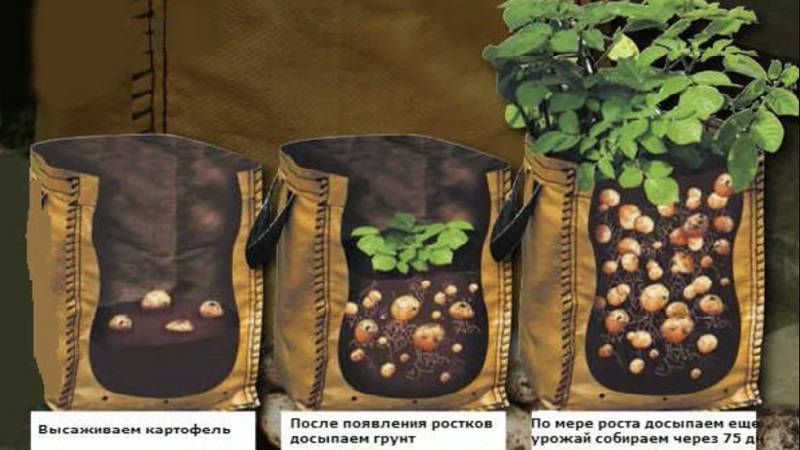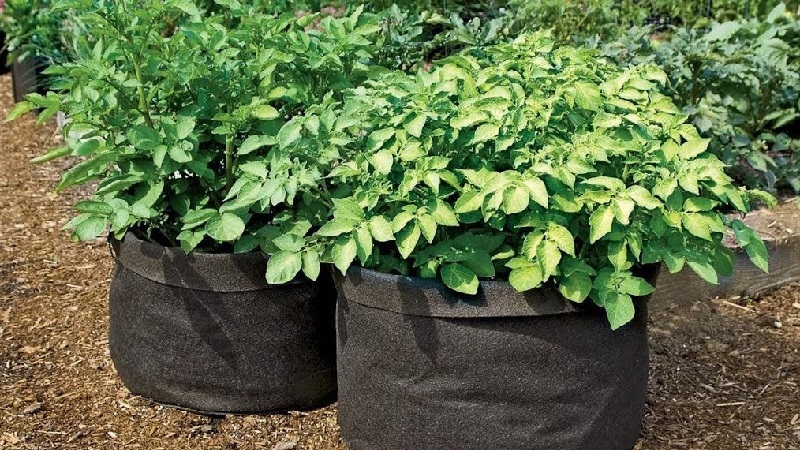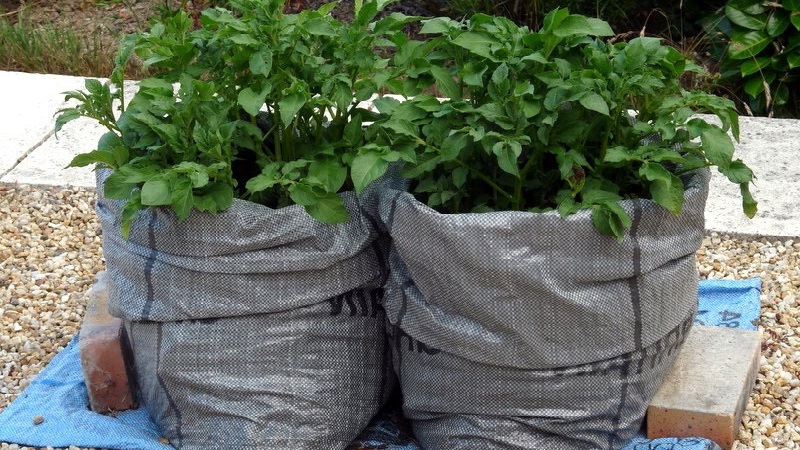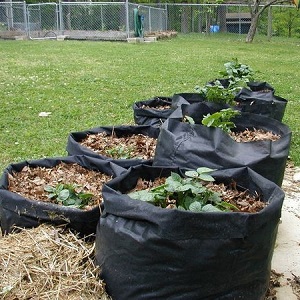Rules for growing potatoes in bags
The traditional method of cultivating potatoes requires a lot of space, so farmers with small plots often resort to a not entirely traditional, but very effective method of planting potatoes in bags. This method saves not only space, but also the time and effort of the gardener, since it does not require digging the garden bed and many other agrotechnical procedures.
Read more about the essence of this method, plant care and harvesting - in this article.
The content of the article
- Features of the method of growing potatoes in bags
- Advantages and disadvantages
- Necessary materials
- Conditions for growing in bags
- Bag cultivation technology
- Further care
- What difficulties can you face in the process of growing in bags?
- When and how to harvest
- Tips and tricks from experienced gardeners
- Conclusion
Features of the method of growing potatoes in bags
Most often, this method of planting potatoes is used when the soil is poor or its area is very limited.
Description and essence of the technique
The essence of the method is to plant tubers in bags filled with a nutritious substrate - it is in them that bushes will grow and tubers will form in the future.

To get a good harvest using this method of planting potatoes, three key conditions are met:
- plant tubers in a loose nutritious substrate;
- provide plants with abundant watering;
- maintain the lighting mode, if necessary using artificial lighting.
It is important to choose the right place for the bags - it must be well lit, accessible for maintenance and located away from the place of water drain.
Are all varieties suitable for this method
For planting in bags, varieties with an early, medium or medium-early ripening period are better. and resistance to culture-specific diseases.
Most popular varieties:
- Bellarosa is an ultra-early variety bred by German breeders that produces large and even pink tubers.
- Santa - potatoes of medium early maturity of the Dutch selection. The tubers are yellow, ripen after 2.5-3 months of planting.
- Slav - mid-early variety, the result of the work of Ukrainian breeders. The crop is ready for harvesting 3-3.5 months after planting.
- Povin is an early-ripening variety of Ukrainian selection, tubers weigh about 200 g and ripen in mid-June - early August.
- Svitanok Kiev - a variety of medium early ripening, bred by Kiev breeders, is characterized by high yields, regardless of climatic conditions.
Some of these varieties can be harvested at the end of May.
Advantages and disadvantages
The main advantages of this method:
 space saving;
space saving;- independence from the soil composition on the site;
- protection of plants from diseases and pests, provided that disinfected materials are used;
- minimization of labor costs;
- the possibility of further use of the substrate as fertilizer for other crops.
Minuses:
- the need to purchase soil, bags and fertilizers;
- rapid depletion and drying of the soil;
- impossibility of multiple use of bags;
- lower yield compared to the traditional method.
Read also:
Necessary materials
To grow potatoes in bags you will need:
- Container... Strong and spacious bags, to which experienced gardeners independently sew a valve for harvesting from below. You can use bags made specifically for growing crops in this way, or polypropylene products that are resistant to moisture and have high moisture and air permeability. Farmers often use bags of sugar, flour or cereals, or even trash bags.
- Substrate... The soil mixture must necessarily be nutritious, disinfected and have good aeration and water permeability.
- Planting material... A correctly selected variety and tubers of suitable size and quality are the key to a good harvest.
Conditions for growing in bags
Cultivation of potatoes in bags will bring a positive result only when creating the necessary conditions for the culture:
- the bags are installed firmly so that they do not sag and do not tilt on their side, if necessary, they are added dropwise or use a support;
- the place should be well lit and have convenient approaches for planting and harvesting;
- provide a system to drain excess water after watering, otherwise it will accumulate around the bags, which can lead to rotting of tubers.
Bag cultivation technology
After purchasing equipment and choosing a suitable place, prepare the substrate and planting material and plant the tubers themselves.

Selection and preparation of containers
Drainage holes are made in the bags, if they are not there initially, moisture stagnation must not be allowed... After that, a drainage layer about 15 cm thick is poured onto the bottom - crushed stone, expanded clay or broken brick will do.
Preparing tubers for planting
Tubers for planting must be firm, free from damage, unpleasant odor or rot... Suitable tuber weight is 30-100 g, it is better to choose medium-sized specimens.
3-4 weeks before planting, the seed is placed in well lit by the sun, warm room at a temperature of + 15… + 20 ° C for germination. The sprouts appear in about 20 days. Non-germinated specimens and tubers with few or too weak sprouts are discarded.
Reference. To improve germination, the room temperature is lowered to + 8 ° C several times a day.
Immediately before bagging tubers must be pickled using one of the solutions:
- copper sulfate (5 g per 3 liters of water);
- potassium permanganate (5 g per 5 l of water);
- Dissolve a mixture of copper sulfate, manganese and boric acid (5 g of each agent per 10 liters of water);
- ash solution (500 g of ash per 5 liters of water).
The tubers are placed in the solution for 2-3 minutes, and then dried.... To prevent disease, tubers are treated with Fitosporin.
Soil preparation
The substrate should be light, nutritious, have good moisture permeability, aeration and slightly acidic reaction (5.5-6.5 pH).
Important! Self-prepared substrate must be calcined or steamed for disinfection before use.
The land from the site is not suitable for this method of growing potatoes, so gardeners or buy a special substrate or prepare it yourself using one of the options:
- a mixture of equal parts of humus and garden soil, with the exception of the one where potatoes or other nightshades used to grow;
- a mixture of a bucket of earth from the garden, a bucket of humus, 2 liters of sand, 1-2 liters of ash and nitrogen-containing fertilizers or rotted manure.
When to plant
Tubers are planted in late May or early June depending on climatic conditions. The optimum air temperature is + 15… + 18 ° C, and the minimum allowable temperature is + 12 ° C.

Early planting of tubers is also acceptable - at the end of March or in April, but the bags are kept indoors until an acceptable temperature is established outside.
Landing technology
Step by step instructions for planting potatoes in bags:
- Tuck the bag up about halfway - it's more convenient to plant this way.
- Pour drainage onto the bottom first, and then - soil mixture (layer thickness about 30 cm).
- Place 2-3 tubers in the ground, eyes up.
- Cover them with a layer of soil (about 20 cm thick) and water sparingly.
When shoots appear, after 1-2 weeks, they are covered with soil mixture and do this until the height of the bag reaches 50-60 cm.
Further care
Crop care using this method is simple - it is enough to properly water and feed the plants. By following all the recommendations, you can increase the yield by 2-3 times.
Top dressing
Fertilizers are applied three times per season:
- when the tops reach a height of 20 cm;
- during budding;
- during flowering.
For feeding potatoes use bird droppings or mullein diluted in water (proportions 1:10) and potash fertilizers.
Reference. Nitrogen fertilizers are not used, since they stimulate the development of green mass, which negatively affects the maturation of tubers.
Top dressing is applied at the root so that the solution does not get on the stem and leaves.

Watering mode
On average, plants are watered once every 7-10 days. at the rate of 2.5-3 liters of water for each bush. Watering is stopped 15-20 days before harvesting.
Protection against diseases and pests
The risk of developing diseases with this method of cultivating potatoes is minimal.... However, you will need to regularly inspect the bushes and, at the first sign of any disease, treat the plants with fungicidal preparations, for example, "Alirin-B" or "Fitosporin-M".
For potatoes grown in bags, the most dangerous pest is ants. To prevent them from appearing around the bags, sprinkle mustard, pepper or poison like "Anteater".
What difficulties can you face in the process of growing in bags?
Problems that may arise:
- development late blight - probably violated the rules of crop rotation;
- other fungal diseases leading to rotting tubers - improper irrigation regime: too much water or no drainage holes.
When and how to harvest
On average, the ripening period of root crops is 2-3.5 months... The crop is harvested from late July to early September, more precise dates depend on the selected variety.
Reference. In the case of planting tubers in bags indoors and then taking them outside, the crop is harvested in June.
For harvesting, a side cut is made in the bag and the tubers are taken out or they do it through special pockets, if provided.
Tips and tricks from experienced gardeners
Experienced farmers recommend:
 To retain moisture and loosen the soil mixture, mulch it with peat or ash.
To retain moisture and loosen the soil mixture, mulch it with peat or ash.- If the bag is made of dense material, make small cuts at the bottom and sides - this will ensure the evaporation of excess moisture and prevent the tubers from rotting.
- Do not use the same substrate for replanting potatoes, as the soil will be devoid of beneficial properties. The soil can be used as a mulch layer on other beds.
Conclusion
With the correct implementation of the technology and proper care, you can count on a rich harvest, even in a small area. The main thing is to choose the right bags and take into account all the nuances regarding the time of planting tubers, watering and fertilizing.